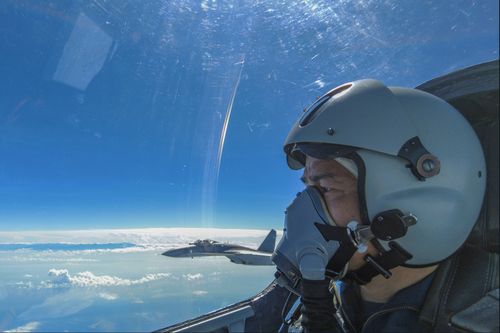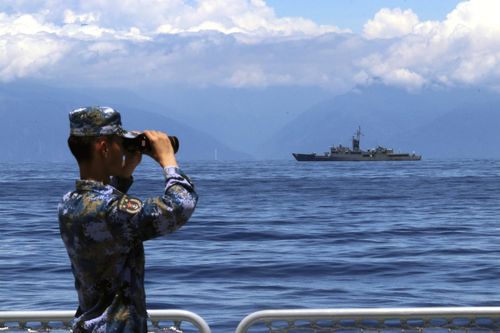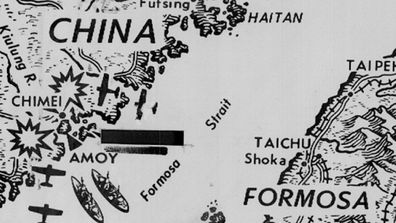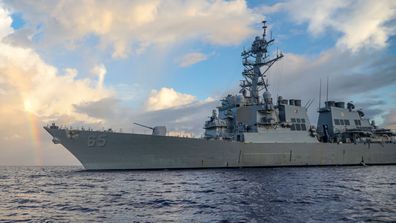

Meng Xiangqing, a professor at the PLA National Defence University, said the six areas were chosen to show how China could cut off Taiwan's ports, attack its most important military installations, and sever access for foreign forces that may come to Taiwan's aid.

"Connect the six areas in a line, like a noose, with the knot of the noose right in the southwest direction," Meng said in an interview with state-run broadcaster CCTV.
China's Communist Party views democratic Taiwan as its territory - despite never having controlled it.
Meng noted the northern exercise areas had successfully sealed off Taiwan from Okinawa, the island where both Japan and the US base substantial military assets.
In the southern areas, the PLA showed it could control the Bashi Channel, "the only way to enter and exit the South China Sea," he said.
And in the eastern areas, China's forces showed that accurate Chinese missile fire could force foreign warships to back away from Taiwan's waters, he added.
"This is an unprecedented encirclement of Taiwan Island," Meng said.
And on Monday, China issued a notice to say drills were continuing.
"I'm not worried, but I'm concerned that they're moving as much as they are. But I don't think they're going to do anything more," Biden said.

A trigger for long-planned exercises
The exercises kicked off after Pelosi angered Beijing by visiting Taipei last week to show her support for democracy on the island.
Beijing flooded the seas and skies around Taiwan with ships and jets - as many as 80 Chinese warplanes and vessels were detected in the Taiwan Strait Sunday, according to Taiwan's Defence Ministry.
On previous days, the PLA also fired rockets toward small, Taiwan-controlled islands near the mainland, and launched ballistic missiles farther afield, with some flying over Taiwan and falling in the ocean east of the island.
Five splashed down in Japan's Exclusive Economic Zone - a message to one of Taiwan's key supporters as well as the government in Taipei.

A map of the six Chinese exercise areas "clearly plots out where the Chinese think the key operating areas are for their strategic intimidation of Taiwan," Mick Ryan, a former Australian Army general and adjunct fellow at the Centre for Strategic and International Studies, wrote on Twitter.
Commercial ships and aircraft were warned to stay clear of the exercise zones, forcing shippers and airlines to arrange alternative routes.
Carl Schuster, a former director of operations at the US Pacific Command's Joint Intelligence Centre in Hawaii said the blockade of six zones showed that any takeover of Taiwan could begin with an isolation strategy.
"The exercise demonstrated that blockade in a conflict need not require a constant naval presence offshore, but rather, shipping and air traffic can be deterred by air and missile threats in support of a maritime blockade," Schuster said.
"The exercise ... suggests Beijing would first isolate Taiwan and resort to air and missile strikes in hopes of breaking Taipei's political will. A costly invasion probably is a last resort," Schuster said.

Schuster said much of what Beijing demonstrated had long been in the works.
The drills coincided with standard military exercises on the PLA's training calendar, but he said Pelosi's visit allowed China to make a bigger statement.
"The size, geographic expanse and complexity of the exercise reflected months of planning," he said.
"This exercise marks the latest escalation in China's expanding military exercise and Taiwan-intimidation campaign."
He said he expects the PLA will continue to put pressure on Taiwan, and could also send a message to Japan with more drills to the north of the island.
New exercises are also likely in the South China Sea, the 3 million square kilometres of water, almost all of which China claims as its sovereign territory, where Beijing has built up military fortifications on contested islands, Schuster said.
While continuing exercises will allow the PLA to refine its tactics and operations, they also can provide an opportunity for adversaries to learn about the modern Chinese military, experts say.
"Nothing provides better insights into the actual capability of a military than seeing them deployed," Ryan wrote on Twitter.

With last week's drills, Xi had to demonstrate he would not waver on his commitment to bringing Taiwan under Beijing's control, Schuster said.
Pelosi's visit to the island posed a direct threat to that by presenting an alternative vision of democracy.
"(Pelosi) leads the democratically elected branch that originates America's government funding and economic policies. Her position and role makes her commitment to Taiwan's security particularly significant," Schuster said.
"Unable to bully her, Xi had to demonstrate China's power - diplomatic, economic and military," he said.
While the military exercises gave Xi strong visuals to support his resolve, China also hit Pelosi and the US government with a range of sanctions.
The measures include the cancellation of future phone calls and meetings between Chinese and US military leaders and the suspension of cooperation on matters including the repatriation of illegal immigrants, legal assistance on criminal matters and the combat of transnational crimes.
Talks on climate change were also suspended.
Beijing also announced measures targeting Pelosi and members of her immediate family.
"The goal is intimidation via the application of all elements of Chinese power," Schuster said.









 Add Category
Add Category
